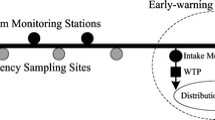Abstract
Predicting and analyzing the future possible scenario of the sudden water pollution accident can help emergency managers to get know the possible future of the accident and make response. In this paper, the Bayesian Network (BN) is extended to support emergency decision for sudden water pollution accidents. Three types of node variables for BN are built according to the characteristics of sudden water pollution accident. Then, the directed acyclic graph (DAG) is constructed to connect the variables. Through Estimating of the conditional probability of BN, the possible scenario of sudden water pollution accident can be formed based DAG and BN. Finally, the Longjiang River cadmium pollution in Guangxi Province is given to illustrate the feasibility and validity of the proposed method. The results show that the BN can give the possible scenario of the sudden pollution accident and can help emergency managers to make detailed alternatives further to minimize the losses.







Similar content being viewed by others
References
Domingos BP, Pazzani M (2012) On the optimality of the simple baysian classi under zero-one loss. Mach Learn 29:103–130
Duan WL, Chen GH, Qing Y, Chen QG (2011) The situation of hazardous chemical accidents in China between 2000 and 2006. J Hazard Mater 86:1489–1494
Farmani R, Henriksen HJ, Savic D (2009) An evolutionary Bayesian belief network methodology for optimum management of groundwater contamination. Environ Model Softw 24:303–310
He Q, Peng S, Zhai JJ, Xiao HW (2011) Development and application of a water pollution emergency response system for the Three Gorges Reservoir in the Yangtze River, China. J Environ Sci 23:595–600
Li Chunhui, Sun Lian, Jia Junxiang, Cai Yanpeng, Wang Xuan (2016) Risk assessment of water pollution sources based on an integrated k-means clustering and set pair analysis method in the region of Shiyan, China. Sci Tot Environ 557–558:307–316
Liu J, Guo L, Jiang JP, Hao LL, Liu RT, Wang P (2015) Evaluation and selection of emergency treatment technology based on dynamic fuzzy GRA method for chemicalcontingency spills. J Hazard Mater 299:306–315
Loo SL, Fane AG, Krantz WB, Lim TT (2012) Emergency water supply: a review of potential technologies and selection criteria. Water Res 46:3125–3151
Managi S, Kaneko S (2009) Environmental performance and returns to pollution abatement in China. Ecol Econ 68:1643–1651
Pendock NE, Sears M (2002) Choosing geological models with Baysian belief networks. S Afr J Sci 98:500–502
Peng JF, Song YH, Yuan PS, Xiao H, Han L (2013) An novel identification method of the environmental risk sources for surface water pollution accidents in chemical industrial parks. J Environ Sci 25:1441–1449
Pollino CA, Woodberry O, Nicholson A, Korb K, Hart BT (2007) Parameterisation and evaluation of a Bayesian network for use in an ecological risk assessment. Environ Model Softw 22:1140–1152
Ratna V, Reddy BB (2006) Impact of water pollution on rural communities: an economic analysis. Ecol Econ 58:520–537
Rebelo A, Ferra I, Goncalves I, Marques AM (2014) A risk assessment model for water resources: releases of dangerous and hazardous substances. J Environ Manage 140:51–59
Rui YK, Shen DT, Khalid S, Yang ZG, Wang JC (2015) GIS-based emergency response system for sudden water pollution accidents. Phys Chem Earth Parts A/B/C 79–82:115–121
Samuels WB, Bahadur R, Ziemniak C (2015) Development and application of the incident command tool for drinking water protection. Water Environ J 29:1–15
Shang ZT, Ren J, Qin MR, Xia Y, He L, Chen YW (2010) The relationship between temperature changing and Taihu blue-green algae. Econ J 29(1):55–61 (In Chinese)
She L, Liu YS, Wu GB (2011) Water pollution emergency incidents: evolutionary model and emergency management. Resour Environ Yangtze Basin 20:1004–1010 (In Chinese)
Shi SG, Cao JC, Feng L, Liang WY, Zhang LQ (2014) Construction of a technique plan repository and evaluation system based on AHP group decision-making foremergency treatment and disposal in chemical pollution accidents. J Hazard Mater 276:200–206
Stergios A, Anastasios X (2012) Pollution control with uncertain stock dynamics: when, and how, to be precautious. J Environ Econ Manage 63:304–320
Tang CH, Yi YJ, Yang ZF, Cheng X (2014) Water pollution risk simulation andprediction in the main canal of the South-to-North Water Transfer Project. J Hydrol 519:2111–2120
The Longjiang River cadmium pollution accident in China (2012) http://news.sina.com.cn/z/longjianghewuran/ (In Chinese)
The Longjiang River cadmium pollution accident in China (2012) http://news.sohu.com/s2012/cdpollution/ (In Chinese)
Xie JL, Li JX, Wang N, Jiang RG (2013) The sudden water pollution diffusion simulation of the river basin based on multi-agent. J Xi’an Univer Technol 29:13–20
Xin K, Yin W, Wang M (2012) Reservoir operation schemes for water pollution accidents in Yangtze River. Water Sci Eng 5:59–66
Zhang B, Wang Q, Sun Q, Li S (2009) Spatio-temporal simulation of water quality based on SD-GIS accidential water pollution. Geomatics Inform Sci Wuhan Univer 34:341–348 (In Chinese)
Acknowledgements
Authors would like to thank the editors and anonymous referees for their valuable comments and suggestions. Their comments helped improve the quality of the paper immensely. The work is supported by the National Social Science Foundation of China (17CXW012).
Author information
Authors and Affiliations
Corresponding author
Appendix
Appendix
Rights and permissions
About this article
Cite this article
Cheng, T., Wang, P. & Lu, Q. Risk scenario prediction for sudden water pollution accidents based on Bayesian networks. Int J Syst Assur Eng Manag 9, 1165–1177 (2018). https://doi.org/10.1007/s13198-018-0724-y
Received:
Published:
Issue Date:
DOI: https://doi.org/10.1007/s13198-018-0724-y












